The History Of Toyota SERA
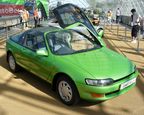
The Toyota Sera (model designation EXY10) is a two door, four seat (2+2) coupe built by Toyota from 1990 to 1996. Although produced solely for the Japanese market, it raised interest overseas and has since been imported by car enthusiasts into several countries including Australia, Bangladesh, Canada, India, Ireland, New Zealand, and the UK. It was initially unveiled in 1988 as the Toyota AXV-II concept car in almost production-ready form. The name comes from the French word meaning "will be", indicative of both the overall futuristic design and also the closeness of the concept car to the final production version. The Sera is most notable for its butterfly doors which tilt up and forward when opened, and the canopy constructed largely of glass panels.
As it was released with only one engine and body type there is technically only one model of the Toyota Sera EXY10. However major option choices such as transmission, brakes and sound-system meant that there were a number of different factory packages. Furthermore, Toyota itself produced three versions (known as 'Phases') over its production life with specific characteristics (such as interior trim), although variations between the three are largely cosmetic.
A total of 15,852 units were built and registered in Japan, however with niche market car importing occurring in the early 1990s it is possible that some vehicles were constructed and exported directly from Japan without first being registered there. As such it is difficult to know exactly how many Seras were produced, although it is certainly less than 16,000 and they are now becoming rare collectibles.
Mechanical
All Seras came with the 1.5L (1496cc) inline 4 5E-FHE unleaded petrol engine, the largest capacity version of Toyota's E series of engines included in other Toyota vehicles such as the Paseo and the Starlet. This was installed in a front-mount, front wheel drive transverse configuration with electronic fuel injection. All versions came with power assisted rack and pinion steering and either a 4 speed automatic or 5 speed manual transmission. The brakes were vented discs at the front and drums at the rear, unless fitted with the optional Anti-Lock Braking system which had vented discs all round.
Mechanically the car is related to both the Toyota Paseo and the Toyota Starlet, sharing similar floorpans, suspension, steering and brakes amongst other items. As such many consumable parts such as brakepads and springs are interchangeable and still readily available from parts suppliers.
Body
The Toyota Sera is of a steel monocoque construction with a low and rounded body shape. It is a two door plus hatch (sometimes referred to as three door or hatchback) coupe. The Sera's most distinctive feature is its butterfly doors, which are hinged at the top and bottom of the A pillar and open forward and up in a manner similar to the McLaren F1 and Saleen S7. The weight of the door is predominantly supported by a thick gas strut, and counter-balanced by a smaller secondary strut inside the door to help take into account changes in temperature. With age these struts can lose pressure causing the doors to sag or fail to stay open, however the issue can be resolved by re-gassing or replacing the strut. Unlike the conventional side-opening doors on most cars, the Sera door can be opened fully in a fairly confined space, requiring only 43 cm of lateral clearance.
The rear hatch is also unusual in being constructed of a single piece of glass without a supporting steel frame. This, in combination with a steeply sloping front windscreen and glass upper-door/ roof panels (a total of six separate glass pieces overall), gives the Sera its characteristic "bubble-like" canopy. This provides occupants with a high level of all-round visibility, although the thick B-pillar can result in a significant blind spot, especially on the driver's side. The unusual amount of glass can also create a high solar load greenhouse effect on bright days causing the interior temperature to rise. This problem however is offset by the fact that the Toyota Sera came with both air-conditioning, and two removable interior roof panels as standard.
As with other cars (such as convertibles) where the upper half has little or no supporting framework, the Sera body is not necessarily as rigid as fixed roof vehicles. This can result in a certain amount of body roll while manoeuvring, although this can also be in part attributed to the overall age of the vehicle and components such as suspension.
Interior
The Toyota Sera is a 2+2 coupe with bucket seats at the front and a rear bench seat with a fixed central arm rest. Both front seats tilt and slide forward to give access to the rear and although the interior is quite compact the deep, form-fitting design of the rear seats means the vehicle can provide space (albeit cramped) in the back for passengers of average height. The front seats in all versions came with three point harnesses while the rear seats came with either two point lap sashes or three-point harnesses depending on the Phase. It is in the specifics of the interior that the majority of the differences in Phases occurs as outlined below.
In its normal interior configuration (with the back seats up and the parcel shelf in place) the rear cargo area does have a noticeably small opening (52cm by 82cm) and an elevated lip necessitating the lifting of luggage quite high before it can be placed inside. However the boot (trunk) is relatively deep and spacious. In addition the rear seats fold down and both the parcel shelf and the rear divider panel (usually in place behind the back seats) can be completely removed, in essence turning the entire rear half of the car into a cargo area. As such the Toyota Sera has a large amount of available storage space for its size. The space-saving spare tire and changing kit are contained in a small compartment below the boot floor.
Other features
The Sera/ EXY-10 was one of the first cars to feature projector headlights (though the 1988 AXV-II concept model featured conventional lights). The Alfa Romeo Stradale is believed to be the first car to feature dihedral doors, which like the Sera, features windows that curve upward into the 'roof' section of the vehicle.
As the Sera was built solely for the Japanese market all cars were right-hand drive as factory standard and the speedometer and odometer units were metric. This makes the car readily importable into countries with similar standards and require only minimal changes for ones such as the United Kingdom (where vehicles are also right-hand drive but instruments are in Imperial units). However, major alterations may be necessary before the Sera is legal for general use in, or even importation into, other countries such as the United States and the majority of European nations. In Australia, most Seras will have required three-point seatbelts and side impact beams to be fitted for compliance, as such it may be beneficial to import a later model Phase III to avoid this third-party work.
The Sera is still very well supported by Toyota for spares, and many overseas dealers are happy to order parts and service the car. In particular, any country where the Toyota Starlet, Cynos or Paseo are common should have good sources for new and secondhand replacement parts as well as qualified repairers and service garages.
The Toyota Sera was produced in three distinct versions, with either manual or automatic transmission, standard or ABS brakes and regular stereo or Super-Live Sound System ("SLSS" - see below) forming the three major choices for buyers. There were also a large number of additional factory options available across the entire production run.
Phase I (March 1990 - May 1991)
The initial build and the majority of the Sera's total production (around 12,000 of the 15,852 or so cars produced). Unique features included:
- beige/ tan interior or greyish blue depending on exterior colour
- bayonet fuel filler cap
- hardwearing ribbed and woven seat material
Phase II (May 1991 - June 1992)
Second version (around 2,300 cars produced). Unique features included:
- pastel pattern in the main sections with tan/ greyish bolsters depending on interior colour
- screw-type fuel filler cap
- different seat materials
Phase III (June 1992 - December 1995)
The final version of the Sera with many more changes than the second phase (remainder of around 1,550 cars produced). Unique features included:
- grey interior with seat fabrics that have a secondary colour to complement the exterior colour
- some engine component revisions
- side impact beams in the doors
- optional airbags (which may have been automatically accompanied by ABS)
- three-point rear seat belts
- stronger door struts to compensate for the side impact beams
- solid plastic spoiler with LED high-level brake light incorporated (the only external change to the Sera)
Phase III "Amlux" Special Edition
The Phase III Sera also featured a limited edition model, the Amlux, named after Toyota's flagship building in Tokyo. The Amlux Building houses the world's largest automobile showroom and is situated in Ikebukuro. It is a one of a kind oval-shaped high rise building that glows purple at night, but with a curious matte-finish look, and flashing white strobes.
The Sera special edition Amlux versions were based on the phase III SERA with automatic transmission and SLSS. Unique features included:
- Two-tone green paint
- Special colour hubcaps
- Blue tinted glass
- Choice of 6 special colours of seat material designs
- Rear seat cover
- AMLUX logo on mats
- AMLUX logo on door
- Personalised name plate on the car
- Personalised seat cushion and also a special scarf
All Phases of the Toyota Sera came with a range of factory optional extras. The major mechanical option was the Anti-Lock Braking System. Additional options included:
- A variety of logo and stripe stickers
- Body kits
- Car-phone and/ or car-fax
- Parking sensors
- Patterned window-tinting
- Roof cover
- Ski-racks (which attached to the doors)
- Smoked glass upper spoiler
- Striking patterned seat & floormat materials
- Various stereo Head Units
Super Live Surround Sound (SLSS)
One major internal option came in the form of an advanced car audio system known as the Super Live Surround Sound or SLSS. The SLSS comprised a total of 10 speakers; 3 x 10cm tweeters in the front console (left, right and centre), 2 x 10cm door-mounted cones (left and right), 2 x tweeters and 2 x cones contained in a single, tube shaped unit mounted on the rear parcel shelf, and a boot fitted 'Acoustic Resonance Woofer' (subwoofer). The SLSS came with a three mode Digital Sound Processor (DSP) which cycled through 'off', 'Casual' or 'Funky' mode by use of a button labelled "WARP" on the CD/ Radio or CD/ Radio/ Cassette head unit. These produced slight differences in sound quality through preset values for settings such as bass and treble, as well as rotating the speakers in the rear unit to either project directly into the car or bounce off the rear window. A complete and functional SLSS is one of the most highly sought after options by Toyota Sera enthusiasts.
Air filtration/ fragrance systems
Toyota Sera buyers could also add one of two different styles of electronic air cleanser/ fresheners. These came in the form of either a standalone roof mounted filter and interior light unit or an integrated device known as an "Air Fantasy" that was mounted in the centre console beneath the audio head-unit. The roof unit took air in through a vent at the front and ran it out through a filter at the back. The Air Fantasy system was connected to the vehicle's own air-conditioning system and would pump small bursts of scented air (from one of three replaceable scent packs) either automatically or on demand through the air vents. Although the roof unit is relatively common for an optional extra, the Air Fantasy is especially rare.
Many Toyota Seras have received aftermarket additions or improvements aimed at extending the usable life of the vehicle, improving the overall performance or to rectify commonly perceived issues such as body roll or poor headlight levels.
Engine tuning
[original research?]
By far the most common mechanical improvement is the tuning or complete replacement of the engine. The factory standard 5E-FHE developed, when new, 110 PS (108 bhp), and is the most powerful of the normally aspirated versions of the Toyota E series engine. However, with minimal modification to the car itself this unit can be replaced with the factory Toyota Starlet GT Turbo or 'Glanza' engine (4E-FTE) which develops 135 PS (133 bhp). This has been successfully transplanted in a number of Seras in Japan, Australia and the UK where the 'bolt-on' nature of the change and the relatively cheap price of both the replacement engine and additional parts (due to the large numbers of Starlets produced) make it much more attractive than tuning the existing 5E-FHE with custom parts. The Starlet Turbo can be additionally tuned to give substantially more power (175-200 bhp) than that released by Toyota. However, in order to achieve these levels of power it is necessary to make quite a number of changes - exchanging the intercooler for a larger version and relocating it to the front bumper, installing a revised exhaust and induction kit, plus a number of electronic engine management devices to alter the fuelling and turbo boost safety points. More specialised options have included using the 4A-GE engine (black top with map sensor) which can produce around 165hp (123kW) giving the car a power to weight ratio of 5.63 kg/ hp (in comparison to the more modern Mazda RX-8 for example which has a power to weight ratio of 5.93 kg/ hp). With a Standalone Engine Management System (EMS/ ECU) and various other engine modifications, the 4A-GE can readily be made to produce around 200hp (150kW), and in excess of 230 bhp with the addition of a larger turbo. At least two Seras in Japan are claimed to have 300bhp (220kW) and one in Australia produces a claimed 290bhp (216kW). These are extremely expensive and specialized conversions as the engines and transmissions have to be strengthened, cooling and fuel issues have to be addressed and improvements are required to the brakes and handling package.
Handling
Despite its sporting coupe image, the Toyota Sera suspension is equipped with much softer springs than might be expected. To compensate this problem an aftermarket handling package is available, developed with the assistance of Leda Suspension. This gives the car a firmer and more sporting drive with less pronounced and more progressive body roll characteristics. The car is lowered slightly as well giving a more aggressive appearance. The kit contains: 1 pair of front dampers, 1 pair of front progressive rate springs, 1 pair of rear dampers, 1 pair of rear progressive rate springs. Because of the suspension similarities between the Sera, Paseo/ Cynos, & Starlet GT, other suspension parts such as swaybars, strut bars, & other braces can be retrofitted. The brakes can also be upgraded for the larger, better Starlet GT front & rear disc brakes.
Bodykits
There are several designs of full bodykit and sections available for the Sera. Popular amongst these are full kits made by G5 Speed Garage (Japan), Quest Power: Type-A (Japan), Cia Style Kit (UK), X-Racing (Australia). and a rear bumper by Andros (Cyprus), Sera bodykits mainly include redesigned and grounded front bumpers, front splitters, carbon-fibre bonnets, wheelarch trims, wide arch kits, front bumper extensions, side skirts, rear spoilers, headlamp eyelids and body mounted rear wings.
Now, nearly two decades since the Sera was launched, it is enjoying a renaissance in popularity, and is becoming recognised as a future classic. Over the past few months, prices of Seras in Japan have risen, not just because of demand from buyers intending to import the car from Japan, but also due to increasing demand for these cars in Japan itself.
From Wikipedia, the free encyclopedia
More About Toyota SERA
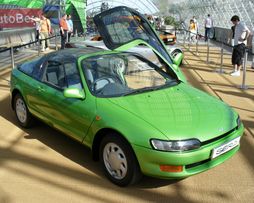
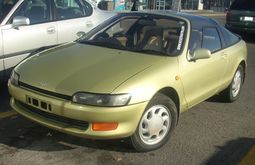
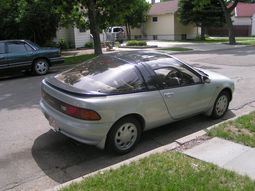
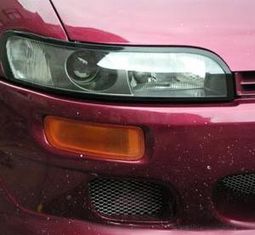
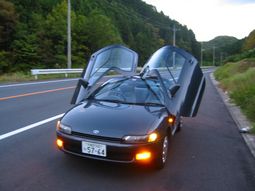
|